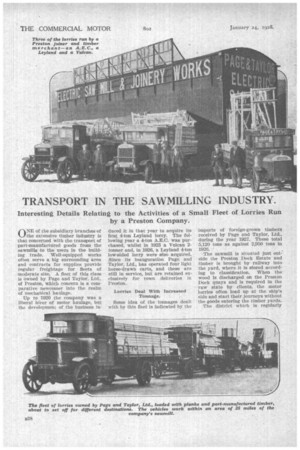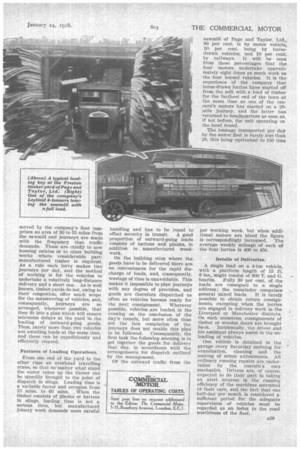TRANSPORT IN THE SAWMILLING INDUSTRY.
Page 46

Page 47

If you've noticed an error in this article please click here to report it so we can fix it.
Interesting Details Relating to the Activities of a Small Fleet of Lorries Run by a Preston Company.
(INE of the subsidiary branches of the extensive timber industry is that concerned with the transport of part-manufactured goods from the sawmills to the users in the building trade. Well-equipped works often serve a big surrounding area and contracts for supplies provide regular freightage for fleets of moderate size. A fleet of this class is owned by Page and Taylor, Ltd., of Preston, which concern is a comparative newcomer into the realm of mechanical haulage.
Up to 1920 the company was a liberal hirer of motor haulage, but the development of the business in
duced it in that year to acquire its first 4-ton Leyland lorry. The following year a 4-ton A.E.C. was purchased, whilst in 1923 a Vulcan 2tonner and, in 1926, a Leyland 4-ton low-sided lorry were also acquired. Since its inauguration Page and Taylor, Ltd., has operated four light horse-drawn carts, and these are still in service, but are retained exclusively for town deliveries in Preston.
Lorries Deal With Increased Tonnage.
Some idea of the tonnages dealt with by this fleet is indicated by the imports of foreign-grown timbers received by Page and Taylor, Ltd., during the year 1927. These total 5,120 tons as against 2,950 tons in 1926. '
The sawmill is situated just outside the Preston Dock Estate and timber is brought by railway into the yard, where it is stored according to classification. When the wood is discharged on the Preston Dock quays and is required in the raw state by clients, the motor lorries often load up at the ship's side and start their journeys without the goods entering the timber yards.
The district which is regularly served by the company's fleet comprises an area of 30 to 35 miles from the sawmill and journeys are made with the frequency that traffic demands. These are chiefly to new housing estates or to other building works where considerable partmanufactured timber is required. As a rule each lorry makes two journeys per day, and the method of working is for the vehicles to undertake a relatively long-distance delivery and a short one. As is well known, timber yards do not, owing to their congestion, offer much scope for the manceuvring of vehicles, and, consequently, journeys are so arranged, whenever possible, that they fit into a plan which will ensure minimum delays at the yard in the loading of outward-going goods. Thus, rarely more than two vehicles are awaiting loads at the same time, and these can be expeditiously and efficiently cleared.
Features of Loading Operations.
From one end of the yard to the other runs an overhead travelling crane, so that no matter what stand the motor takes up the timber can be speedily brought to the point of dispatch in slings. Loading time is a variable factor and occupies from 15 mins. to 60 mins. When the timber consists of planks or battens in slings, loading time is not a serious item, but manufactured joinery work demands more careful
handling and has to be roped to effect security in transit. A good proportion of outward-going loads consists of battens and planks, in addition to manufactured woodwork.
On the building sites where the goods have to be delivered there are no conveniences for the rapid discharge of loads, and, consequently, wastage of time is unavoidable. This makes it impossible to plan journeys with any degree of precision, and goods are therefore dispatched as often as vehicles become ready for the next consignment. Wherever possible, vehicles are loaded in the evening on the conclusion of the day's rounds, but more often than not the late completion of the journeys does not enable this plan to be followed. Consequently, the first task the following morning is to get together the goods for delivery that day, in accordance with the arrangements for dispatch outlined by the management.
Of the outward traffic from the sawmill of Page and Taylor, Ltd., 80 per cent. is by motor vehicle, 10 per cent. being by horsedrawn vehicles, and 10 per cent. by railways. It will be seen from these percentages that the four motors undertake approximately eight times as much work as the four horsed vehicles. It is the experience of the company that horse-drawn lorries have started off from the mill with a load of timber for the farthest end of the town at the same time as one of the concern's motors has started on a 20mile journey, and the latter has returned to headquarters as soon as, if not before, the unit operating on the local round.
The tonnage transported per day by the motor fleet is rarely less than 28, this being equivalent to 150 tons per working week, but when additional motors are hired the figure is correspondingly increased. The average weekly mileage of each of the four lorries is 400 to 450.
Details of Deliveries.
A single load on a 4-ton vehicle, with a platform length of 15 ft. 6 ins., might consist of 600 T. and G. boatels. Fully 30 per cent. of the loads are consigned to a single address; the remainder comprises general mixed loads. It is rarely possible to obtain return consignments, excepting when the lorries are engaged in delivery work in the Liverpool or Manchester districts. On such occasions, consignments of timber or wooden doors are brought back. Incidentally, the driver and his assistant always assist in the unloading of vehicles.
One vehicle is detained in the garage every Saturday morning for examination, cleaning and the making of minor adjustments. All ordinary running repairs are undertaken by the concern's own mechanics. Drivers are, of course, expected to do their part in taking an alert interest in the running efficiency of the machines entrusted to their care, and the fact that one half-day per month is considered a sufficient period for the adequate supervision of vehicles must be regarded as an index to the road worthiness of the fleet.




































































































